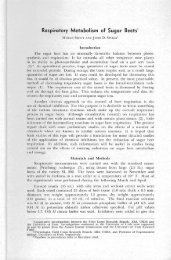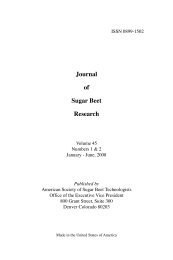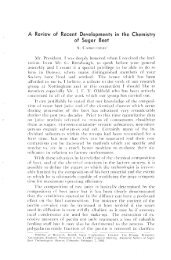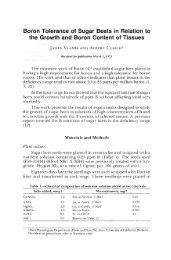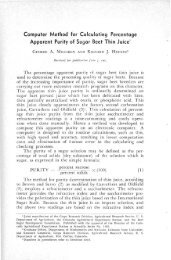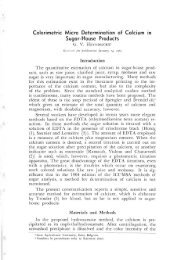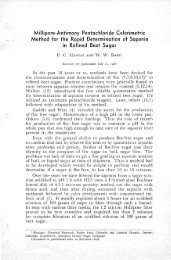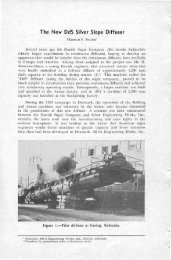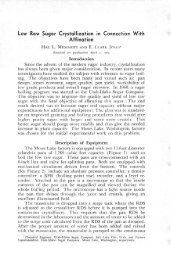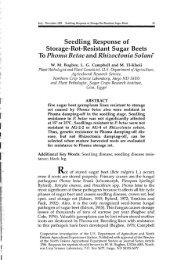Pathogenic and Phylogenetic Analysis of Fusarium oxysporum ... - Vol
Pathogenic and Phylogenetic Analysis of Fusarium oxysporum ... - Vol
Pathogenic and Phylogenetic Analysis of Fusarium oxysporum ... - Vol
You also want an ePaper? Increase the reach of your titles
YUMPU automatically turns print PDFs into web optimized ePapers that Google loves.
38 Journal <strong>of</strong> Sugar Beet Research <strong>Vol</strong>. 49 Nos. 1 & 2<br />
<strong>Pathogenic</strong> <strong>and</strong> <strong>Phylogenetic</strong><br />
<strong>Analysis</strong> <strong>of</strong> <strong>Fusarium</strong> <strong>oxysporum</strong> from<br />
Sugarbeet in Michigan <strong>and</strong> Minnesota<br />
K.M. Webb 1 , P.A. Covey 1 , <strong>and</strong> L.E. Hanson 2<br />
1 USDA-Agricultural Research Service, Sugar Beet Research Unit,<br />
1701 Centre Ave., Ft. Collins, CO 80526; 2 USDA-Agricultural<br />
Research Service, Sugarbeet <strong>and</strong> Bean Research Unit, 494 PSSB,<br />
Michigan State University, East Lansing, MI 48824<br />
Corresponding author: Kimberly Webb (kimberly.webb@ars.usda.gov)<br />
DOI: 10.5274/jsbr.49.1.38<br />
ABSTRACT<br />
<strong>Fusarium</strong> yellows <strong>of</strong> sugarbeet (Beta vulgaris), caused<br />
by <strong>Fusarium</strong> <strong>oxysporum</strong> f. sp. betae, can lead to a significant<br />
reduction in root yield, sucrose percentage,<br />
<strong>and</strong> juice purity. <strong>Fusarium</strong> yellows has become increasingly<br />
common in both Michigan <strong>and</strong> Minnesota<br />
sugarbeet production areas, <strong>and</strong> although genetic resistance<br />
provides some control, growers have reported<br />
failures when resistant varieties are grown in different<br />
parts <strong>of</strong> the country, potentially due to the variability<br />
<strong>of</strong> local F. <strong>oxysporum</strong> populations. Previous research<br />
has demonstrated that the F. <strong>oxysporum</strong> population<br />
collected from symptomatic sugarbeet can be highly<br />
variable in pathogenicity but that this is not solely due<br />
to the wide geographic distribution <strong>of</strong> sugarbeet production.<br />
F. <strong>oxysporum</strong> isolates were collected from<br />
symptomatic sugarbeet throughout the production region<br />
<strong>of</strong> Michigan <strong>and</strong> Minnesota <strong>and</strong> were characterized<br />
utilizing pathogenicity <strong>and</strong> phylogenetic analyses.<br />
The F. <strong>oxysporum</strong> population from Michigan <strong>and</strong> Minnesota<br />
was found to be inconsistent in pathogenicity<br />
to sugarbeet <strong>and</strong> was polyphyletic. Therefore, the population<br />
from Michigan <strong>and</strong> Minnesota could not be<br />
classified into distinct races, but rather was described<br />
adequately by three previously reported phylogenetic<br />
clades.<br />
Additional key words: Beta vulgaris, <strong>Fusarium</strong> yellows,<br />
gene sequencing, genetic diversity
Jan. - June 2012 <strong>Pathogenic</strong> & <strong>Phylogenetic</strong> / <strong>Fusarium</strong> 39<br />
<strong>Fusarium</strong> yellows, caused by <strong>Fusarium</strong> <strong>oxysporum</strong><br />
Schlechtend:Fr. f. sp. betae (Stewart) Snyd & Hans (Stewart, 1931;<br />
Snyder <strong>and</strong> Hansen, 1940; Ruppel, 1991), is a disease <strong>of</strong> sugarbeet<br />
(Beta vulgaris L.), which can lead to a significant reduction in root<br />
yield, sucrose percentage <strong>and</strong> juice purity in affected plants (Hanson<br />
<strong>and</strong> Jacobsen, 2009). <strong>Fusarium</strong> yellows was first reported <strong>and</strong> described<br />
by Stewart (1931) from symptomatic sugarbeets from the<br />
Arkansas Valley in Southeastern Colorado. Symptoms include grayish-brown<br />
vascular tissue in roots, interveinal yellowing <strong>and</strong> wilting<br />
<strong>of</strong> leaves, <strong>and</strong> eventual death <strong>of</strong> the plant (Stewart, 1931; Schneider<br />
<strong>and</strong> Whitney, 1986; Franc et al., 2001). Since that time, <strong>Fusarium</strong><br />
yellows has increased in significance in the Central High Plains <strong>of</strong><br />
the United States including Colorado, Montana, Nebraska, <strong>and</strong><br />
Wyoming as well as some parts <strong>of</strong> Texas (Harveson <strong>and</strong> Rush, 1997;<br />
Panella <strong>and</strong> Lewellen, 2005). Until recently, <strong>Fusarium</strong> yellows has<br />
had little impact on sugarbeet production in the Red River Valley <strong>of</strong><br />
Minnesota <strong>and</strong> North Dakota or in Michigan. <strong>Fusarium</strong> yellows was<br />
first reported in the Red River Valley in 2002 (Windels et al., 2005)<br />
<strong>and</strong> in Michigan in 2005 (Hanson, 2006). Since these initial reports,<br />
<strong>Fusarium</strong> yellows has become increasingly common, particularly in<br />
Minnesota sugarbeet production areas, possibly due to increased<br />
planting <strong>of</strong> susceptible varieties (Khan et al., 2003; Burlakoti, 2007;<br />
Rivera et al., 2008). In Michigan, <strong>Fusarium</strong> yellows has not been reported<br />
widely; however, <strong>Fusarium</strong> <strong>oxysporum</strong> f. sp. betae has been<br />
found on plants from various areas (Hanson, unpublished).<br />
<strong>Fusarium</strong> <strong>oxysporum</strong> is considered to be a species complex <strong>of</strong> morphologically<br />
indistinguishable strains (Lievens et al., 2008), containing<br />
pathogenic <strong>and</strong> non-pathogenic members assigned to formae<br />
speciales based on host specificity (Armstrong <strong>and</strong> Armstrong, 1981).<br />
Although F. <strong>oxysporum</strong> can be classified into formae speciales, this<br />
designation does not indicate that host specificity has resulted from<br />
a single (monophyletic) source but rather comprises a species complex<br />
with polyphyletic origin (Baayen et al., 2000). Many methods<br />
have been used to characterize the genetic diversity <strong>and</strong> evolutionary<br />
origin <strong>of</strong> F. <strong>oxysporum</strong> f. sp. betae from sugarbeet, including vegetative<br />
compatibility grouping (VCG) (Harveson <strong>and</strong> Rush, 1997), restriction<br />
fragment length polymorphism (RFLP) (Nitschke et al., 2009), r<strong>and</strong>om-amplified<br />
polymorphic DNA marker (RAPDs) (Cramer et al.,<br />
2003), <strong>and</strong> comparisons <strong>of</strong> DNA sequences from conserved genomic<br />
regions (Hill et al., 2011). While many <strong>of</strong> these technologies have<br />
been useful in distinguishing F. <strong>oxysporum</strong> from other <strong>Fusarium</strong> spp.,<br />
they do little to describe the regional variation <strong>of</strong> populations <strong>of</strong> F.<br />
<strong>oxysporum</strong> f. sp. betae <strong>and</strong> are unable to differentiate between pathogenic<br />
<strong>and</strong> non-pathogenic isolates.<br />
Previous work by Hill et al. (2011) utilized three conserved genetic<br />
regions; ß-tubulin (Koenraadt et al., 1992), a translation elongation<br />
factor 1a (TEF-1a) (O'Donnell et al., 1998), <strong>and</strong> the internal tran-
40 Journal <strong>of</strong> Sugar Beet Research <strong>Vol</strong>. 49 Nos. 1 & 2<br />
scribed spacer (ITS) region <strong>of</strong> the rRNA 5.8S gene (White et al.,<br />
1990), to characterize a set <strong>of</strong> F. <strong>oxysporum</strong> isolates collected from<br />
sugarbeet. The authors found that genetic relatedness <strong>of</strong> F. <strong>oxysporum</strong><br />
isolates collected from sugarbeet did not correlate with pathogenicity,<br />
preventing them from reliably identifying pathogenic F.<br />
<strong>oxysporum</strong> f. sp. betae isolates from non-pathogenic isolates. Additionally,<br />
they found that genetic variation within F. <strong>oxysporum</strong> f. sp.<br />
betae was organized loosely into multiple clades, very generally based<br />
on production region (Hill et al., 2011). However, few F. <strong>oxysporum</strong><br />
isolates from Michigan <strong>and</strong> Minnesota production regions were included<br />
in this work. It is unknown how the diversity <strong>of</strong> F. <strong>oxysporum</strong><br />
f. sp. betae isolates from this region with increasing instances <strong>of</strong><br />
<strong>Fusarium</strong> yellows, compares with pathogen populations in other regions<br />
<strong>of</strong> sugarbeet production.<br />
Studies with another <strong>Fusarium</strong> species complex, F. solani, have<br />
highlighted the advantage <strong>of</strong> developing multi-locus DNA sequencing<br />
schemes to characterize pathogen diversity (O'Donnell et al., 2008;<br />
Balmas et al., 2010). In addition to the ß-tubulin, TEF-1a, <strong>and</strong> ITS;<br />
genomic sequences from mitochondrial rDNA (mtSSU) <strong>and</strong> Histone<br />
3 genes (H3) have been reported to be effective in characterizing F.<br />
<strong>oxysporum</strong> isolates by pathogenicity for several other formae speciales<br />
(Donaldson et al., 1995; Baayen et al., 2000). Previous work<br />
has shown that the ITS gene sequence, while useful in characterizing<br />
other <strong>Fusarium</strong> spp., is ineffective for characterizing the F. <strong>oxysporum</strong><br />
species complex (Donaldson et al., 1995; Baayen et al., 2000; Hill<br />
et al., 2011), therefore we did not use this locus in our studies. In<br />
this work, we utilized ß-tubulin, TEF-1a, mtSSU, <strong>and</strong> H3 gene sequences<br />
to characterize a population <strong>of</strong> F. <strong>oxysporum</strong> isolated from<br />
symptomatic sugarbeets from Michigan <strong>and</strong> Minnesota <strong>and</strong> associate<br />
their genetic variation with a previously described population <strong>of</strong> F.<br />
<strong>oxysporum</strong> f. sp. betae.<br />
MATERIALS AND METHODS<br />
Isolates<br />
Twenty nine isolates <strong>of</strong> F. <strong>oxysporum</strong> were used in this study. All<br />
isolates were collected originally from symptomatic sugarbeet, singlespored<br />
or hyphal-tipped, <strong>and</strong> stored with proper maintenance, either<br />
in the Sugar Beet Research Unit culture collection located at Ft.<br />
Collins, CO, or the Sugarbeet <strong>and</strong> Bean Research Unit culture collection<br />
located at East Lansing, MI. Isolates are maintained in culture<br />
collections either as filter paper stocks, silica gel stocks, or lyophilized<br />
culture stocks, using accepted protocols <strong>and</strong> appropriately maintained<br />
as described by Leslie <strong>and</strong> Summerell (2006) (Table 1). Fourteen <strong>of</strong><br />
the 29 isolates were previously described in Hill et al. (2011) <strong>and</strong> were<br />
used here to anchor our results to previously reported results (Table
Jan. - June 2012 <strong>Pathogenic</strong> & <strong>Phylogenetic</strong> / <strong>Fusarium</strong> 41<br />
1). Working cultures <strong>of</strong> all isolates used for this study, were maintained<br />
on potato dextrose agar plates (PDA; Becton, Dickinson <strong>and</strong><br />
Co.) at room temperature, <strong>and</strong> transferred only 2-3 times to maintain<br />
viability <strong>of</strong> isolates, using established protocols as described by Leslie<br />
<strong>and</strong> Summerell (2006). One F. avenaceum isolate (F20), that is moderately<br />
virulent to sugarbeet, was used as an outgroup for building<br />
phylogenetic trees.<br />
<strong>Pathogenic</strong>ity Testing<br />
<strong>Pathogenic</strong>ity had been determined on some <strong>of</strong> the isolates previously<br />
(Hill et al., 2011), using the same described protocol, <strong>and</strong> therefore,<br />
were not repeated. Isolates that had undetermined<br />
pathogenicity, were tested at USDA-ARS facilities in either Fort<br />
Collins, CO or East Lansing, MI (Table 1). A susceptible sugarbeet<br />
cultivar ‘FC716’ (Panella et al., 1995) was grown in a greenhouse at<br />
approximately 28°C <strong>and</strong> 16 h daylight, as previously described (Hanson<br />
<strong>and</strong> Hill, 2004). Six weeks after sowing, plants were gently removed<br />
from the soil, rinsed under running tap water, <strong>and</strong> placed in a<br />
conidial spore suspension (~1X10 5 CFU per mL) prepared as described<br />
by Hanson <strong>and</strong> Hill (2004) for 8 min with intermittent agitation.<br />
Control sugarbeet roots were placed in sterile distilled water.<br />
Two pathogenic F. <strong>oxysporum</strong> f. sp. betae isolates (F19 <strong>and</strong> Fob220a)<br />
were included during all pathogenicity testing as positive controls.<br />
Five to 10 individual beets per isolate were then replanted into 10<br />
cm x 25 cm cone-tainers (Steuwe <strong>and</strong> Sons, Inc.) containing premoistened,<br />
pasteurized potting mix (Farfard #2-SV, American Clay<br />
Works). Plants were then placed back into a greenhouse, in a r<strong>and</strong>omized<br />
complete block design for 2 days at approximately 22°C to<br />
reduce transplant shock, after which temperatures were raised to<br />
28°C with 16 h <strong>of</strong> daylight for the remainder <strong>of</strong> the incubation period.<br />
Isolates were tested for pathogenicity by repeating the experiment<br />
twice. Plants were rated weekly for <strong>Fusarium</strong> yellows symptoms for<br />
6 weeks after inoculation using a 0 to 5 rating scale as described by<br />
Hanson et al. (2009). A rating <strong>of</strong> 0 = no disease; 1 = leaves wilted,<br />
small chlorotic areas on lower leaves, most <strong>of</strong> leaf green; 2 = leaves<br />
showing interveinal yellowing; 3 = leaves have small areas <strong>of</strong> necrosis<br />
or becoming necrotic <strong>and</strong> dying, less than half <strong>of</strong> the leaves affected;<br />
4 = more than half <strong>of</strong> leaves dead, plant stunted, most living leaves<br />
showing symptoms; 5 = plant death. <strong>Pathogenic</strong>ity was determined<br />
using the most severe disease rating, which occurred on the sixth<br />
week after inoculation. Isolates with a mean rating at the sixth week<br />
<strong>of</strong> 2 or above were considered to be pathogenic (Ruppel, 1991).<br />
DNA Isolation<br />
Isolates were grown in 50 mL potato dextrose broth (PDB; Becton,<br />
Dickinson <strong>and</strong> Co.) by inoculating with a 7 mm diameter mycelia<br />
plug. Cultures were grown in the dark for 5 days at 25°C on a rotary
Table 1. Geographic origin <strong>and</strong> pathogenicity on sugarbeet (cv. FC716) <strong>of</strong> <strong>Fusarium</strong> <strong>oxysporum</strong> isolates included in<br />
phylogenetic studies.<br />
Geographic Year <strong>of</strong> Source <strong>of</strong><br />
Isolate Origin Isolation <strong>Pathogenic</strong>ityy † <strong>Pathogenic</strong>ityData ‡<br />
F02-105 MN 2002 NP (0.4) Ft. Collins, CO<br />
F02-78 MN 2002 NP (0.4) Ft. Collins, CO<br />
F05-157 MN 2005 NP (0.5) Ft. Collins, CO<br />
F05-77 MN 2005 NP (0.5) Ft. Collins, CO<br />
F07-35 MI 2007 NP (0.9) Ft. Collins, CO<br />
F07-43 MI 2007 NP (0.9) Ft. Collins, CO<br />
F07-52 MI 2007 NP (1.0) Ft. Collins, CO<br />
F08-10 MI 2008 NP/P (1.1/2.0) Ft. Collins, CO/East Lansing, MI<br />
F08-11 MI 2008 NP (0.7) Ft. Collins, CO<br />
F08-13 MI 2008 NP/P (1.1/2.1) Ft. Collins, CO/East Lansing, MI<br />
F08-174 MI 2008 NP (0.7) Ft. Collins, CO<br />
F08-184 MI 2008 NP (0.6) Ft. Collins, CO<br />
F08-49 MI 2008 NP (0.8/1.8) Ft. Collins, CO/East Lansing, MI<br />
F17 OR 2001 P (3.0) Hill et al (2011) <br />
F19 OR 2001 P (3.8) Ft. Collins, CO<br />
F28 CO 2001 P (2.1) Hill et al (2011) <br />
Fo17 MN 2004 NP (1.7) Hill et al (2011) <br />
Fo22/<strong>Fusarium</strong> #1 MN 1998 NP (0.7) Hill et al (2011) <br />
42 Journal <strong>of</strong> Sugar Beet Research <strong>Vol</strong>. 49 Nos. 1 & 2
Fo23/<strong>Fusarium</strong> #2 MN 1998 NP (0.6) Hill et al (2011) <br />
Fo25/<strong>Fusarium</strong> #4 MN 1998 NP (0.7) Hill et al (2011) <br />
Fo27/<strong>Fusarium</strong> #6 MN 1998 NP (1.0) Hill et al (2011) <br />
Fo29/<strong>Fusarium</strong> #8 MN 1998 NP (0.7) Hill et al (2011) <br />
Fo37 MN 2004 NP (1.7) Hill et al (2011) <br />
FOB13/F180 OR 1994 P (2.5) Hill et al (2011) <br />
F174 CA 1995 NP (1.8) Hill et al (2011) <br />
Fob220a CO 1998 P (3.3) Hill et al (2011) <br />
Fob257a CO 1998 P (3.4) Hill et al (2011) <br />
H8 MT 2004 P (2.9) Hill et al (2011) <br />
F20 § OR 2001 P (2.5) Hill et al (2011) <br />
† Those isolates with an average disease severity rating <strong>of</strong> greater than 2 are considered to be pathogenic (P);<br />
isolates with an average disease severity rating less than 2 are non-pathogenic (NP) (Ruppel, 1991); isolates<br />
that were tested during multiple experiments are indicated with multiple pathogenicity designations; bold<br />
indicates isolates that had discrepancies in pathogenicity testing.<br />
‡ Source (or the location/researcher) that performed pathogenicity testing; USDA-ARS, Ft. Collins, CO (Kimberly<br />
Webb), USDA-ARS, East Lansing, MI (Linda Hanson), or previously reported in Hill et al (2011) at USDA-ARS,<br />
Ft. Collins, CO.<br />
§ Indicates single F. avenaceum isolate that was included as an out-group to anchor phylogenetic trees. Indicates isolates<br />
previously reported in Hill et al (2011) <strong>and</strong> included to root our results to published phylogenetic trees.<br />
Jan. - June 2012 <strong>Pathogenic</strong> & <strong>Phylogenetic</strong> / <strong>Fusarium</strong> 43
Table 2. Primer sequences <strong>and</strong> melting temperatures (TM) for polymerase chain reactions.<br />
Gene Forward Primer (5’-3’) Reverse Primer (5’-3’) Reference TM<br />
TEF-1a EF1- EF2-<br />
ATGGGTAAGGA(A/G)GACAAGAC GGA(G/A)GTACCAGT(G/C)ATCATGTT O’Donnell et. al., 1998 59°C<br />
ß-tubulin C- D-<br />
GAGGAATTCCCAGACCGTATGATG GCTGGATCCTATTCTTTGGGTCGAACAT Koenraadt et. al., 1992 58°C<br />
mtSSU MS1- MS2-<br />
CAGCAGTCAAGAATATTAGTCAATG GCGGATTATCGAATTAAATAAC White et. al., 1990 52°C<br />
Histone-3 H31a-ACTAAGCAGACCGCCCGCAGG H31b-GCGGGCGAGCTGGATGTCCTT Glass <strong>and</strong> Donaldson 1995 55°C<br />
44 Journal <strong>of</strong> Sugar Beet Research <strong>Vol</strong>. 49 Nos. 1 & 2
Jan. - June 2012 <strong>Pathogenic</strong> & <strong>Phylogenetic</strong> / <strong>Fusarium</strong> 45<br />
shaker at 100 rpm. Mycelia masses were collected by filtering<br />
through sterile cheese cloth, rinsed with de-ionized water, <strong>and</strong> then<br />
lyophilized at -50°C for 48 h. Lyophilized tissue was ground into a<br />
fine powder using a spatula, <strong>and</strong> DNA extracted using the Invitrogen<br />
Easy-DNA extraction kit (Carlsbad, CA) utilizing the protocol for<br />
small amounts <strong>of</strong> plant tissues.<br />
DNA Amplification <strong>and</strong> Sequencing<br />
Primers for PCR amplification <strong>of</strong> TEF1-a, ß-tubulin, mtSSU, <strong>and</strong><br />
H3 were used as previously described (Table 2), as were corresponding<br />
PCR conditions (O'Donnell et al., 1998; Koenraadt et al., 1992;<br />
White et al., 1990; Glass <strong>and</strong> Donaldson, 1995). Fermentas br<strong>and</strong><br />
(Glen Burnie, MD) Taq polymerase was used for all PCR amplifications.<br />
Briefly, one cycle <strong>of</strong> 94°C for 2 min followed by 32 cycles <strong>of</strong> 94°C<br />
for 45 sec, gene specific target melting temperatures (Tm) (Table 2)<br />
for 45 sec, <strong>and</strong> an extension cycle <strong>of</strong> 72°C for 1 min, followed by final<br />
extension cycle <strong>of</strong> 72°C for 5 min. PCR products were held at 4°C<br />
until they could be removed from a Mastercyler gradient thermo cycler<br />
(Eppendorf, Hamburg, Germany). All reactions were repeated<br />
at least twice. PCR amplicons were visualized on a 1.5% agarose gel<br />
<strong>and</strong> purified using either the Epoch Genecatch PCR Clean up kit<br />
(Sugarl<strong>and</strong>, TX) or extracted from the agarose gels <strong>and</strong> purified using<br />
the Epoch Genecatch Gel Extraction Clean up kit (Sugarl<strong>and</strong>, TX).<br />
Products were sequenced in both directions by Eur<strong>of</strong>ins,<br />
MWG/Operon (Huntsville, AL).<br />
<strong>Phylogenetic</strong> <strong>Analysis</strong><br />
Gene sequences from the amplified PCR products for each gene<br />
(TEF1-a, ß-tubulin, mtSSU, <strong>and</strong> H3), were manually edited using<br />
Sequencher v. 4.1 (Gene Codes Corp). ClustalX v 1.83 (Thompson et<br />
al., 1997) was used to align sequences from all isolates for each gene.<br />
An individual data set was generated for each gene using the sequence<br />
data from all isolates for that gene. Parsimony bootstrap<br />
analysis was carried out in PAUP 4.0b10 (Sw<strong>of</strong>ford, 1999) with 1000<br />
r<strong>and</strong>om stepwise replicates, the tree-bisection-reconnection branchswapping<br />
procedure, <strong>and</strong> MULTREES <strong>of</strong>f (Debry <strong>and</strong> Olmstead,<br />
2000) for each gene data set. F. avenaceum isolate F20 was used as<br />
an outgroup to anchor all trees. Ambiguously aligned flanking sequences<br />
were not included in phylogenetic analyses. To determine<br />
the ability to combine the four individual gene datasets, parsimony<br />
analysis utilizing a partition-homogeneity test (Farris et al., 1995;<br />
Hill et al., 2011) was implemented using PAUP, with 1000 homogeneity<br />
replicates <strong>and</strong> MAXTREES set to 1000. Additionally, Bayesian<br />
MCMC phylogenetic analysis using MrBayes 3.0 (Ronquist <strong>and</strong><br />
Huelsenbeck, 2003) was used to assess the combined data set <strong>and</strong><br />
compare with the parsimony analysis. The General Time Reversible<br />
(GTR) model (Felsenstein, 2004) was used <strong>and</strong> a proportion <strong>of</strong> invari-
46 Journal <strong>of</strong> Sugar Beet Research <strong>Vol</strong>. 49 Nos. 1 & 2<br />
able sites <strong>and</strong> a gamma-shaped distribution <strong>of</strong> rates across sites utilizing<br />
two simultaneous chains <strong>of</strong> 1.5 x 10 7 generations <strong>and</strong> a sample<br />
frequency <strong>of</strong> 300, for a total <strong>of</strong> 50000 sample trees, were used as parameters<br />
from each chain replicate. The same parameters were applied<br />
for all four data partitions.<br />
RESULTS AND DISCUSSION<br />
F. <strong>oxysporum</strong> pathogenicity to sugarbeet<br />
Of the 29 F. <strong>oxysporum</strong> isolates included in this study, 10 were<br />
considered to be pathogenic <strong>and</strong> either highly virulent or moderately<br />
virulent to sugarbeet (34%; Table 1). Only two <strong>of</strong> the isolates from<br />
Michigan or Minnesota were considered to be at least moderately virulent<br />
to sugarbeet (Table 1). A mean disease severity rating <strong>of</strong> 2,<br />
where plants are starting to show distinct <strong>Fusarium</strong> yellows symptoms<br />
(i.e. leaves showing interveinal yellowing) indicates that the inoculated<br />
isolate is capable <strong>of</strong> eliciting a pathogenic response in the<br />
host (Ruppel, 1991; Hanson <strong>and</strong> Hill, 2004). Therefore, isolates that<br />
had a mean disease severity rating <strong>of</strong> 2 or above were considered to<br />
be pathogenic to sugarbeet. To characterize virulence, pathogenic<br />
isolates with a rating <strong>of</strong> 2-3 are considered as moderately virulent<br />
<strong>and</strong> those with a rating <strong>of</strong> greater than 3-5 are highly virulent (Hanson<br />
<strong>and</strong> Hill, 2004). Many F. <strong>oxysporum</strong> f. sp. betae isolates with moderate<br />
or low virulence to sugarbeet have been reported to give<br />
variable disease severity ratings, which are not always significantly<br />
different from negative controls (water <strong>and</strong>/or uninoculated) over repeated<br />
experiments (Hanson <strong>and</strong> Hill, 2004; Hill et al., 2011). This<br />
is particularly evident when testing isolates in multiple locations, as<br />
we found here, where there may be environmental differences in<br />
growing <strong>and</strong> testing conditions (Stewart, 1931; Martyn et al., 1989;<br />
Ruppel, 1991; Hanson <strong>and</strong> Hill, 2004; Hill et al., 2011). In this study,<br />
there were two isolates (F08-10 <strong>and</strong> F08-13; Table 1) that had a discrepancy<br />
in pathogenicity at the two testing locations (Fort. Collins,<br />
CO <strong>and</strong> East Lansing, MI). Both <strong>of</strong> these isolates had disease severity<br />
ratings that ranged from 1.1 to 2.0 indicating that they may be<br />
moderately virulent isolates under appropriate testing conditions<br />
(Table 1). Experimental factors such as environment, soil medium<br />
or conditions, <strong>and</strong> plant growing conditions as well as the inherent<br />
variability <strong>of</strong> F. <strong>oxysporum</strong> f. sp. betae, can complicate the characterization<br />
<strong>of</strong> virulence <strong>and</strong> aggressiveness, <strong>and</strong> the determination <strong>of</strong><br />
pathogenicity between laboratories. Additional studies to st<strong>and</strong>ardize<br />
environmental <strong>and</strong> testing factors, which influence F. <strong>oxysporum</strong><br />
f. sp. betae virulence or <strong>Fusarium</strong> yellows symptom development<br />
should be undertaken to minimize these discrepancies, <strong>and</strong> used to<br />
develop a st<strong>and</strong>ard protocol for determining pathogenicity.<br />
Ruppel (1991) reported that ~40% <strong>of</strong> F. <strong>oxysporum</strong> that were iso-
Jan. - June 2012 <strong>Pathogenic</strong> & <strong>Phylogenetic</strong> / <strong>Fusarium</strong> 47<br />
lated from symptomatic sugarbeet were indeed “pathogens” <strong>of</strong> the<br />
host. Hanson <strong>and</strong> Hill (2004) reported a slightly lower rate <strong>of</strong> recoverable<br />
pathogenic F. <strong>oxysporum</strong> isolates collected from symptomatic<br />
sugarbeet over the entire United States production region. Hanson<br />
<strong>and</strong> Hill (2004) also reported that ~55% <strong>of</strong> their pathogenic F. <strong>oxysporum</strong><br />
isolates were considered highly virulent, <strong>and</strong> 44% moderately<br />
virulent. We found only 14% <strong>of</strong> the Michigan/Minnesota isolates<br />
tested in this study were pathogenic. Based on previous reports, we<br />
did not find that pathogenic F. <strong>oxysporum</strong> isolates from<br />
Michigan/Minnesota were being recovered at a higher rate <strong>and</strong> did<br />
not seem more virulent than those found in other sugarbeet production<br />
regions. This does not indicate that the F. <strong>oxysporum</strong> population<br />
in Michigan <strong>and</strong> Minnesota, which is displaying an increasing incidence<br />
<strong>of</strong> <strong>Fusarium</strong> yellows, is unique from other production regions.<br />
However, a more complete sampling <strong>of</strong> symptomatic sugarbeet from<br />
known infected fields may indicate an increased level <strong>of</strong> virulence<br />
<strong>and</strong> should be considered in the future.<br />
<strong>Phylogenetic</strong> analysis <strong>of</strong> a set <strong>of</strong> F. <strong>oxysporum</strong> from symptomatic<br />
sugarbeet<br />
<strong>Phylogenetic</strong> trees utilizing individual datasets for H3 or mtSSU<br />
gene sequences, did not provide any additional resolution <strong>of</strong> genetic<br />
relatedness <strong>of</strong> F. <strong>oxysporum</strong> isolates from sugarbeet, than presented<br />
by Hill et al. (2011) utilizing ITS, TEF1-a, or ß-tubulin (Fig. 1a-d).<br />
Each <strong>of</strong> the four gene trees identified the same putative primary<br />
groups (clades A-C) reported by Hill et al. (2011). TEF1-a resulted<br />
in the highest resolution among isolates, whereas mtSSU, ß-tubulin,<br />
<strong>and</strong> finally H3, had decreasingly less resolution. Of the four datasets,<br />
H3, with the least resolution, indicated evidence <strong>of</strong> discordant groupings,<br />
particularly for some isolates. For example, Fo37 <strong>and</strong> F174,<br />
were found to group into clade C using H3 but were grouped within<br />
clade B using TEF1-a , ß-tubulin, <strong>and</strong> mtSSU (Fig1a-d). This incongruence<br />
is widespread among many fungi (Martin et al., 1999; Pantou<br />
et al., 2003; Mb<strong>of</strong>ung et al., 2007). Previous research has shown that<br />
some isolates <strong>of</strong> F. <strong>oxysporum</strong> within the species complex, can have<br />
conflicting relationships depending on the gene being analyzed (O'-<br />
Donnell et al., 2009). O’Donnell et al (2009) speculated that some <strong>of</strong><br />
this discordance may have resulted from either gene duplication with<br />
subsequent divergence or via horizontal gene transfer <strong>and</strong>/or introgressive<br />
hybridization events. One possibility is that F. <strong>oxysporum</strong><br />
isolates obtained from sugarbeet may similarly contain members that<br />
have genetic contributions from more than one source. However, it<br />
is also possible that the discordance is due to other factors, such as<br />
variable numbers <strong>of</strong> sub-repeats or divergence <strong>of</strong> gene (O’Donnell,<br />
2009). Future studies are needed to characterize the source <strong>of</strong> the<br />
discordant signal from the H3 gene complex.<br />
Assessment <strong>of</strong> the congruency <strong>of</strong> parsimony consensus indices,
48 Journal <strong>of</strong> Sugar Beet Research <strong>Vol</strong>. 49 Nos. 1 & 2<br />
Fig. 1. Parsimony bootstrap phylograms for each reference gene<br />
(a) TEF1-a (b) ß-tubulin (c) H3 <strong>and</strong> (d) mtSSU. Only Branches<br />
with bootstrap scores <strong>of</strong> 70% or higher are shown. F. avenaceum<br />
isolate (F20) was used as an out group for each phylogram. Isolates<br />
labeled with * have conflicting clade assignments when analyzed<br />
using H3 relative to the clade designations when analyzed using<br />
other reference genes.
Jan. - June 2012 <strong>Pathogenic</strong> & <strong>Phylogenetic</strong> / <strong>Fusarium</strong> 49<br />
Fig. 2. Bayesian MCMC analysis <strong>of</strong> the combined data set from<br />
TEF1-a, ß-tubulin, mtSSU, <strong>and</strong> H3. Only Bayesian posterior-probabilities<br />
(x100) above 50 are shown. F. avenaceum isolate (F20) was<br />
used as an out group for the phylogram. <strong>Pathogenic</strong>ity <strong>and</strong> geographic<br />
origin for each isolate are shown. (NP) Non-pathogenic (P)<br />
<strong>Pathogenic</strong>.<br />
using the partition-homogeneity test, (P=0.001) indicated that the<br />
TEF-1a, ß-tubulin, H3 <strong>and</strong> MtSSU consensus indices <strong>of</strong> the combined<br />
data sets are significantly heterogeneous <strong>and</strong> therefore could<br />
not be combined using parsimony bootstrap analysis. One explanation<br />
for this is the discordant groupings <strong>of</strong> some <strong>of</strong> the isolates within<br />
clade B (Fo37 <strong>and</strong> F174) <strong>of</strong> the H3 dataset (Fig. 1c). Bayesian analysis<br />
therefore was used to analyze each gene as a separate data partition<br />
using the GTR model because this analysis does not require<br />
homogeneity <strong>of</strong> gene partitions. With this analysis, the three primary<br />
clades (A-C) again were supported (Fig. 2). The consensus analysis<br />
utilizing all four genes, does not suggest a link with pathogenicity to<br />
sugarbeet nor to geographic region, supporting the findings <strong>of</strong> Hill et<br />
al. (2011; Fig. 2). Isolates that represent the F. <strong>oxysporum</strong> population<br />
collected from symptomatic sugarbeet in the United States can be
50 Journal <strong>of</strong> Sugar Beet Research <strong>Vol</strong>. 49 Nos. 1 & 2<br />
separated into three clades (A-B), regardless <strong>of</strong> production region<br />
that isolates were obtained. Adding additional isolates from a particular<br />
region, such as Michigan <strong>and</strong> Minnesota, did not strengthen<br />
weak correlations to geographic region previously seen by Hill et al<br />
(2011). While most <strong>of</strong> the Michigan <strong>and</strong> Minnesota isolates from this<br />
study grouped into clade C, several isolates from Minnesota fell into<br />
clade A, which primarily contains isolates from Oregon, <strong>and</strong> clade B<br />
(Fig. 2).<br />
The continued inability to resolve pathogenic from non-pathogenic<br />
isolates, supports the conclusion that pathogenic F. <strong>oxysporum</strong> f. sp.<br />
betae isolates more likely evolved independently, multiple times.<br />
However due to the difficulty with assigning pathogenicity to some<br />
isolates (i.e. weakly virulent) <strong>and</strong> the influence <strong>of</strong> testing conditions<br />
<strong>and</strong>/or environment, it is possible that a genotype by environment<br />
interaction may be confounding phylogenetic associations. Correll<br />
(1991) hypothesized that endophytic, but non-pathogenic populations,<br />
<strong>of</strong> F. <strong>oxysporum</strong> may occur in a population. He speculates that this<br />
“basal” population would have a higher degree <strong>of</strong> diversity with many<br />
mutations towards virulence occurring among independent isolates.<br />
If such mutations occurred when an isolate was in close proximity to<br />
a susceptible host (i.e. the high sucrose environment <strong>of</strong> a sugar beet<br />
root), or under the correct environmental conditions, then this isolate<br />
could become pathogenic, favoring a more “opportunistic” pathogen<br />
population. It is clear that isolates with borderline pathogenic relationships<br />
require further study, particularly to characterize how environment<br />
(including host genotype) influences the F. <strong>oxysporum</strong> f.<br />
sp. betae population.<br />
Because one gene dataset was not more informative than another<br />
in describing the F. <strong>oxysporum</strong> population from sugarbeet (Hill et al<br />
2011, this work), we recommend use <strong>of</strong> only a single dataset (TEF-<br />
1a) for future studies. TEF-1a was chosen because it contains a high<br />
level <strong>of</strong> nucleotide diversity within the F. <strong>oxysporum</strong> species complex<br />
(O'Donnell et al., 1998; Baayen et al., 2000; O'Donnell et al., 2009)<br />
<strong>and</strong> is currently the primary dataset that is being used by the F. <strong>oxysporum</strong><br />
research community for diagnostic identification to species,<br />
as well as phylogenetic analysis <strong>of</strong> the species complex (Geiser et al.,<br />
2004; Lievens et al., 2008). Utilizing only TEF-1a, we have built a<br />
phylogenetic tree, incorporating the published work <strong>of</strong> Hill et al<br />
(2011) with the findings reported here to show the diversity <strong>of</strong> the F.<br />
oxyporum population from sugarbeet (Fig. 3).<br />
In sugarbeet, genetic resistance is the primary method <strong>of</strong> controlling<br />
<strong>Fusarium</strong> yellows (Hanson <strong>and</strong> Jacobsen, 2009) however, variability<br />
in the effectiveness <strong>of</strong> this resistance has been shown<br />
(MacDonald, 1975; Ruppel, 1991; Hanson et al., 2009). Due to the<br />
morphological, genetic, <strong>and</strong> phenotypic variability <strong>of</strong> F. <strong>oxysporum</strong> f.<br />
sp. betae, it is important that breeding programs screen with pathogenic<br />
isolates that represent the diversity found in the production re-
Jan. - June 2012 <strong>Pathogenic</strong> & <strong>Phylogenetic</strong> / <strong>Fusarium</strong> 51<br />
Fig. 3. Parsimony bootstrap analysis <strong>of</strong> the TEF1-a gene for the F.<br />
<strong>oxysporum</strong> population isolated from sugarbeet including those previously<br />
reported by Hill et al. (2011). Isolates in bold indicate new<br />
data being added from this work. Only branches with bootstrap<br />
scores <strong>of</strong> 50% or higher are shown. F. avenaceum isolate (F20) was<br />
used as an out group for each phylogram. <strong>Pathogenic</strong>ity <strong>and</strong> geographic<br />
origin for each isolate are shown. (NP) Non-pathogenic (P)<br />
<strong>Pathogenic</strong> (ND) Not-determined.
52 Journal <strong>of</strong> Sugar Beet Research <strong>Vol</strong>. 49 Nos. 1 & 2<br />
gion <strong>of</strong> interest. For example, varieties for commercial production in<br />
Michigan <strong>and</strong> Minnesota should be screened with isolates that fall<br />
within clade C, but the addition <strong>of</strong> representative isolates from clade<br />
A is also recommended. Utilizing only a single gene (TEF-1a) the<br />
sugarbeet research community can continue to characterize the<br />
diversity <strong>of</strong> the F. <strong>oxysporum</strong> f. sp. betae population, <strong>and</strong> carefully select<br />
representative isolates for germplasm screening <strong>and</strong> cultivar<br />
deployment in the future.<br />
ACKNOWLEDGEMENTS<br />
We would like to thank Amy Hill, for helping in the initial processing<br />
<strong>of</strong> PCR samples <strong>and</strong> gene sequencing. Mention <strong>of</strong> trade<br />
names or commercial products in this publication is solely for the<br />
purpose <strong>of</strong> providing specific information <strong>and</strong> does not imply<br />
recommendation or endorsement by the U.S. Department <strong>of</strong><br />
Agriculture. USDA is an equal opportunity provider <strong>and</strong> employer.<br />
LITERATURE CITED<br />
Armstrong, G.M., <strong>and</strong> J.K. Armstrong. 1981. Formae speciales <strong>and</strong> races <strong>of</strong><br />
<strong>Fusarium</strong> <strong>oxysporum</strong> causing wilt diseases. p. 391-399. In P.E.<br />
Nelson, T.A. Toussoun, <strong>and</strong> R.J. Cook (ed.) <strong>Fusarium</strong>:Diseases,<br />
Biology, <strong>and</strong> Taxonomy. The Pennsylvania State University Press,<br />
University Park, PA.<br />
Baayen, R.P., K. O’Donnell, P.J.M. Bonants, E. Cigelnik, L.P.N. Kroon, R.J.A.<br />
Roebroeck, <strong>and</strong> C. Waalwijk. 2000. Gene genealogies <strong>and</strong> AFLP<br />
analyses in the <strong>Fusarium</strong> <strong>oxysporum</strong> complex identify monophyletic<br />
<strong>and</strong> nonmonophyletic formae speciales causing wilt <strong>and</strong> rot<br />
diseases. Phytopathology 90:891-900.<br />
http://dx.doi.org/10.1094/PHYTO.2000.90.8.891<br />
Balmas, V., Q. Migheli, B. Scherm, P. Garau, K. O’Donnell, G. Ceccherelli, S.<br />
Kang, <strong>and</strong> D.M. Geiser. 2010. Multilocus phylogenetics show high<br />
levels <strong>of</strong> endemic Fusaria inhabiting Sardinian soils (Tyrrhenian<br />
Isl<strong>and</strong>s). Mycologia 102:803-812. http://dx.doi.org/10.3852/09-201<br />
Burlakoti, P. 2007. <strong>Fusarium</strong> species associated with sugarbeet grown in the<br />
Red River Valley: <strong>Pathogenic</strong>ity, cultivar response, <strong>and</strong> baseline<br />
sensitivity to fungicides. MS North Dakota State University.<br />
Correll, J.C. 1991. The relationship between formae speciales, races, <strong>and</strong><br />
vegetative compatibility groups in <strong>Fusarium</strong> <strong>oxysporum</strong>.<br />
Phytopathology 81:1061-1064.
Jan. - June 2012 <strong>Pathogenic</strong> & <strong>Phylogenetic</strong> / <strong>Fusarium</strong> 53<br />
Cramer, R.A., P.F. Byrne, M.A. Brick, L. Panella, E. Wickliffe, <strong>and</strong> H.F.<br />
Schwartz. 2003. Characterization <strong>of</strong> <strong>Fusarium</strong> <strong>oxysporum</strong> isolates<br />
from common bean <strong>and</strong> sugar beet using pathogenicity assays <strong>and</strong><br />
R<strong>and</strong>om-amplified Polymorphic DNA markers. J. <strong>of</strong> Phytopathol.<br />
151:352-360. http://dx.doi.org/10.1046/j.1439-0434.2003.00731.x<br />
Debry, R.W., <strong>and</strong> R.G. Olmstead. 2000. A simulation study <strong>of</strong> reduced treesearch<br />
effort in bootstrap resampling analysis. Systemic Biol.<br />
49:171-179. http://dx.doi.org/10.1080/10635150050207465<br />
Donaldson, G.C., L.A. Ball, P.E. Axelrood, <strong>and</strong> N.L. Glass. 1995. Primer sets<br />
developed to amplify conserved genes from filamentous<br />
ascomycetes are useful in differentiating <strong>Fusarium</strong> species<br />
associated with conifers. App. Environ. Microbiol. 61:1331-1340.<br />
Farris, J.S., M. Kallersjo, A.G. Kluge, <strong>and</strong> C. Bult. 1995. Testing <strong>of</strong><br />
significance <strong>of</strong> incongruence. Cladistics 10:315-319.<br />
http://dx.doi.org/10.1111/j.1096-0031.1994.tb00181.x<br />
Felsenstein, J. 2004. Inferring phylogenies. Sinauer Associates, Sunderl<strong>and</strong>,<br />
Mass.<br />
Franc, G. D., R. M. Harveson, E. D. Kerr, <strong>and</strong> B. J. Jacobsen, 2001. Disease<br />
Management Sugarbeet Production Guide. Lincoln, NE, University<br />
<strong>of</strong> Nebraska.<br />
Geiser, D.M., M.M. Jimenez-Gasco, S. Kang, I. Makalowska, N.<br />
Veeraraghavan, T.J. Ward, N. Zhang, G.A. Kuldau, <strong>and</strong> K.<br />
O’Donnell. 2004. FUSARIUM-ID v. 1.0: A DNA sequence database<br />
for identifying <strong>Fusarium</strong>. Eur. J. Plant Pathol. 110:473-479.<br />
http://dx.doi.org/10.1023/B:EJPP.0000032386.75915.a0<br />
Glass, N.L., <strong>and</strong> G.C. Donaldson. 1995. Development <strong>of</strong> primer sets<br />
designed for use with the PCR to amplify conserved genes from<br />
filamentous ascomycetes. App. Environ. Microbiol. 61:1323-1330.<br />
Hanson, L.E. 2006. First Report <strong>of</strong> <strong>Fusarium</strong> yellows <strong>of</strong> sugar beet caused by<br />
<strong>Fusarium</strong> <strong>oxysporum</strong> in Michigan. Plant Dis. 90:1554.<br />
http://dx.doi.org/10.1094/PD-90-1554B<br />
http://dx.doi.org/10.1094/PD-90-0686A<br />
Hanson, L.E., <strong>and</strong> A.L. Hill. 2004. <strong>Fusarium</strong> species causing <strong>Fusarium</strong><br />
yellows o<strong>of</strong> sugarbeet. J. Sugar Beet Res. 41:163-178.<br />
http://dx.doi.org/10.5274/jsbr.41.4.163
54 Journal <strong>of</strong> Sugar Beet Research <strong>Vol</strong>. 49 Nos. 1 & 2<br />
Hanson, L.E., A.L. Hill, B.J. Jacobsen, <strong>and</strong> L. Panella. 2009. Response <strong>of</strong><br />
sugar beet lines to isolates <strong>of</strong> <strong>Fusarium</strong> <strong>oxysporum</strong> f. sp. betae from<br />
the United States. J. Sugar Beet Res. 46:11-26.<br />
http://dx.doi.org/10.5274/jsbr.46.1.11<br />
Hanson, L.E., <strong>and</strong> B.J. Jacobsen. 2009. <strong>Fusarium</strong> Yellows. p. 28-29. In<br />
R.M.Harveson, L.E. Hanson, <strong>and</strong> G.L. Hein (ed.) Compendium <strong>of</strong><br />
Beet Diseases <strong>and</strong> Pests. American Phytopathological Society, St.<br />
Paul, Minnesota.<br />
Harveson, R.M., <strong>and</strong> C.M. Rush. 1997. Genetic variation among <strong>Fusarium</strong><br />
<strong>oxysporum</strong> isolates from sugarbeet as determined by vegetative<br />
compatibility. Plant Dis. 81:85-88.<br />
http://dx.doi.org/10.1094/PDIS.1997.81.1.85<br />
Hill, A.L., P.A. Reeves, R.L. Larson, A.L. Fenwick, L.E. Hanson, <strong>and</strong> L.<br />
Panella. 2011. Genetic variability among isolates <strong>of</strong> <strong>Fusarium</strong><br />
<strong>oxysporum</strong> from sugar beet. Plant Pathol. 60:496-505.<br />
http://dx.doi.org/10.1111/j.1365-3059.2010.02394.x<br />
Khan, M., C. A. Bradley, <strong>and</strong> C. E. Windels, <strong>Fusarium</strong> yellows <strong>of</strong> sugarbeet.<br />
2003. PP-1247. Univ. Minn. Ext. Serv. <strong>and</strong> North Dakota State Univ.<br />
Ext. Serv.<br />
Koenraadt, H., S.C. Somerville, <strong>and</strong> A.L. Jones. 1992. Characterization <strong>of</strong><br />
mutations in the Beta-tubulin gene <strong>of</strong> benomyl-resistant field strains<br />
<strong>of</strong> Venturia inaequalis <strong>and</strong> other plant pathogenic fungi.<br />
Phytopathology 82:1348-1354.<br />
http://dx.doi.org/10.1094/Phyto-82-1348<br />
Leslie, J.F., <strong>and</strong> B.A. Summerell. 2006. The <strong>Fusarium</strong> Laboratory Manual.<br />
First ed. Blackwell Publishing, Ames, Iowa.<br />
http://dx.doi.org/10.1002/9780470278376<br />
Lievens, B., M. Rep, <strong>and</strong> B.P. Thomma. 2008. Recent developments in the<br />
molecular discrimination <strong>of</strong> formae speciales <strong>of</strong> <strong>Fusarium</strong><br />
<strong>oxysporum</strong>. Pest Manag. Sci. 64:781-788.<br />
http://dx.doi.org/10.1002/ps.1564<br />
MacDonald, J.D. 1975. The pathogenicity, host specificity, <strong>and</strong> seed<br />
association <strong>of</strong> the sugarbeet stalk blight pathogen <strong>Fusarium</strong><br />
<strong>oxysporum</strong> f. sp. betae. MS University <strong>of</strong> California, Davis.<br />
Martin, F., M. Selosse, <strong>and</strong> F. Le Tacon. 1999. The nuclear rDNA intergenic<br />
spacer <strong>of</strong> the ectomycorrhizal basidiomycete Laccaria bicolor:<br />
structural analysis <strong>and</strong> allelic polymorphism. Microbiology 145:1605-<br />
1611. http://dx.doi.org/10.1099/13500872-145-7-1605
Jan. - June 2012 <strong>Pathogenic</strong> & <strong>Phylogenetic</strong> / <strong>Fusarium</strong> 55<br />
Martyn, R.D., C.M. Rush, C.A. Biles, <strong>and</strong> E.H. Baker. 1989. Etiology <strong>of</strong> a root<br />
rot disease <strong>of</strong> sugar beet in Texas. Plant Dis. 73:879-884.<br />
http://dx.doi.org/10.1094/PD-73-0879<br />
Mb<strong>of</strong>ung, G.Y., S.G. Hong, <strong>and</strong> B.M. Pryor. 2007. Phylogeny <strong>of</strong> <strong>Fusarium</strong><br />
<strong>oxysporum</strong> f. sp. lactucae inferred from mitochondrial small subunit,<br />
elongation factor 1-a, <strong>and</strong> nuclear ribosomal intergenic spacer<br />
sequence data. Phytopathology 97:87-98.<br />
http://dx.doi.org/10.1094/PHYTO-97-0087<br />
Nitschke, E., M. Nihlgard, <strong>and</strong> M. Varrelmann. 2009. Differentiation <strong>of</strong> eleven<br />
<strong>Fusarium</strong> spp. isolated from sugar beet, using restriction fragment<br />
analysis <strong>of</strong> a polymerase chain reactionamplified translation<br />
elongation factor 1a gene fragment. Phytopathology 99:921-929.<br />
http://dx.doi.org/10.1094/PHYTO-99-8-0921<br />
O’Donnell, K., H.C. Kistler, E. Cigelnik, <strong>and</strong> R.C. Ploetz. 1998. Multiple<br />
evolutionary origins <strong>of</strong> the fungus causing Panama disease <strong>of</strong><br />
banana: Concordant evidence fom nuclear <strong>and</strong> mitochondrial gene<br />
genealogies. Proc. Natl. Acad. Sci. 95:2044-2049.<br />
http://dx.doi.org/10.1073/pnas.95.5.2044<br />
O’Donnell, K., D.A. Sutton, A. Fothergill, D. McCarthy, M.G. Rinaldi, M.E.<br />
Br<strong>and</strong>t, N. Zhang, <strong>and</strong> D.M. Geiser. 2008. Molecular phylogenetic<br />
diversity, multilocus haplotype nomenclature, <strong>and</strong> in vitro antifungal<br />
resistance within the <strong>Fusarium</strong> solani species complex. J. Clin.<br />
Microbiol. 46:2477-2490. http://dx.doi.org/10.1128/JCM.02371-07<br />
O’Donnell, K., C. Gueidan, S. Sink, P.R. Johnston, P.W. Crous, A. Glenn, R.<br />
Riley, N.C. Zitomer, P. Colyer, C. Waalwijk, T.V.D. Lee, A. Moretti,<br />
S. Kang, H.S. Kim, D.M. Geiser, J.H. Juba, R.P. Baayen, M.G.<br />
Cromey, S. Bithell, D.A. Sutton, K. Skovgaard, R. Ploetz, H. Corby<br />
Kistler, M. Elliott, M. Davis, <strong>and</strong> B.A.J. Sarver. 2009. A two-locus<br />
DNA sequence database for typing plant <strong>and</strong> human pathogens<br />
within the <strong>Fusarium</strong> <strong>oxysporum</strong> species complex. Fungal Genet.<br />
Biol. 46:936-948. http://dx.doi.org/10.1016/j.fgb.2009.08.006<br />
Panella, L., <strong>and</strong> R.T. Lewellen. 2005. Objectives <strong>of</strong> sugar beet breeding:<br />
<strong>Fusarium</strong> yellows. p. 93-95. In E.Biancarki, L.G. Campbell, G.N.<br />
Skaracis, <strong>and</strong> M. De Biaggi (ed.) Genetics <strong>and</strong> Breeding <strong>of</strong> Sugar<br />
Beet. Science Publishers, Inc., Enfield, New Hampshire.<br />
Panella, L., E.G. Ruppel, <strong>and</strong> R.J. Hecker. 1995. Registration <strong>of</strong> four<br />
multigerm sugar beet germplasm resistant to Rhizoctonia root rot:<br />
FC716, FC717, FC718, <strong>and</strong> FC719. Crop Sci. 35:291-292.<br />
http://dx.doi.org/10.2135/cropsci1995.0011183X003500010071x
56 Journal <strong>of</strong> Sugar Beet Research <strong>Vol</strong>. 49 Nos. 1 & 2<br />
Pantou, M.P., A. Mavridou, <strong>and</strong> M.A. Typas. 2003. IGS sequence variation,<br />
group-I introns <strong>and</strong> the complete nuclear ribosomal DNA <strong>of</strong> the<br />
entomopathogenic fungus Metarhizium: excellent tools for isolate<br />
detection <strong>and</strong> phylogenetic analysis. Fungal Genet. Biol. 38:159-<br />
174.http://dx.doi.org/10.1016/S1087-1845(02)00536-4<br />
Rivera, V., J. Rengifo, M. Khan, D.M. Geiser, M. Mansfield, <strong>and</strong> G. Secor.<br />
2008. First Report <strong>of</strong> a novel <strong>Fusarium</strong> species causing yellowing<br />
decline <strong>of</strong> sugar beet in Minnesota. Plant Dis. 92:1589.<br />
http://dx.doi.org/10.1094/PDIS-92-11-1589B<br />
Ronquist, F., <strong>and</strong> J.P. Huelsenbeck. 2003. MrBayes 3: Bayesian phylogenetic<br />
inference under mixed models. Bioinformatics 19:1572-1574.<br />
http://dx.doi.org/10.1093/bioinformatics/btg180<br />
Ruppel, E.G. 1991. <strong>Pathogenic</strong>ity <strong>of</strong> <strong>Fusarium</strong> spp. from diseased sugarbeets<br />
<strong>and</strong> variation among sugarbeet isolates <strong>of</strong> F. <strong>oxysporum</strong>. Plant Dis.<br />
75:486-489. http://dx.doi.org/10.1094/PD-75-0486<br />
Schneider, C.L., <strong>and</strong> E.D. Whitney. 1986. <strong>Fusarium</strong> yellows. p. 18. In E.D.<br />
Whitney, <strong>and</strong> J.E. Duffus (ed.) Compendium <strong>of</strong> Beet Diseases <strong>and</strong><br />
Insects. APS Press, St. Paul, MN.<br />
Snyder, W.C., <strong>and</strong> H.N. Hansen. 1940. The species concept in <strong>Fusarium</strong>.<br />
Am. J. Botany 27:64-67. http://dx.doi.org/10.2307/2436688<br />
Stewart, D. 1931. Sugar-beet yellows caused by <strong>Fusarium</strong> conglutinans var.<br />
betae. Phytopathology 21:59-70.<br />
Sw<strong>of</strong>ford, D. 1999. PAUP: <strong>Phylogenetic</strong> <strong>Analysis</strong> Using Parsimony. Version<br />
4.Ob1. Sinauer Associates, Sunderl<strong>and</strong>, MA, USA.<br />
Thompson, J.D., T.J. Gibson, F. Plewniak, F. Jeanmougin, <strong>and</strong> D.G. Higgins.<br />
1997. The CLUSTAL_X windows interface: flexible strategies for<br />
multiple sequence alignment aided by quality analysis tools. Nucleic<br />
Acids Res. 25:4876-4882. http://dx.doi.org/10.1093/nar/25.24.4876<br />
White, T.J., T. Bruns, S. Lee, <strong>and</strong> J. Taylor. 1990. Amplification <strong>and</strong> direct<br />
sequencing <strong>of</strong> fungal ribosomal RNA genes for phylogenetics. p.<br />
315-322. In M.A.Innis, G.H. Gelf<strong>and</strong>, J.J. Sninsky, <strong>and</strong> T.J. White<br />
(ed.) PCR Protocols: A Guide to Methods <strong>and</strong> Applications.<br />
Academic Press, Inc.<br />
Windels, C.E., J.R. Brantner, C.A. Bradley, <strong>and</strong> M.F.R. Khan. 2005. First<br />
Report <strong>of</strong> <strong>Fusarium</strong> <strong>oxysporum</strong> causing yellows on sugar beet in the<br />
Red River Valley <strong>of</strong> Minnesota <strong>and</strong> North Dakota. Plant Dis. 89:341.<br />
http://dx.doi.org/10.1094/PD-89-0341B



